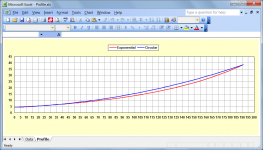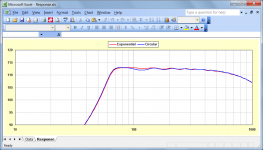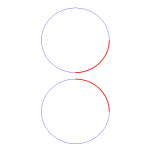What happens when one builds a round bass horn where the curve of the flare is a portion of a circle?
Hi dustman96,
It depends on the radius of the circle defining the flare profile, but no matter what, the performance is not going to be anywhere near as good as that of a similar-length conventional exponential or hyperbolic-exponential horn. Rest assured, if a "circular" flare was suitable for bass horns, it would have been adopted well before now
Kind regards,
David
Hi dustman96,
It depends on the radius of the circle defining the flare profile, but no matter what, the performance is not going to be anywhere near as good as that of a similar-length conventional exponential or hyperbolic-exponential horn. Rest assured, if a "circular" flare was suitable for bass horns, it would have been adopted well before now.
Kind regards,
David
When you say performance are you referring to low frequency loading of the driver?
When I look at an exponential flare profile I see very little difference between that and a section of a circle, visually anyway. I see the circle as being just a bit closer to conical than exponential. Is my perception flawed?
How would you recommend I go about truly understanding how horns work? Do you have some good resources you could recommend?
Thank you David.
P.S. Thank you also for HornResp. Is hornresp able to model the "circular" profile so I can compare it to others?
When I look at an exponential flare profile I see very little difference between
that and a section of a circle, visually anyway. I see the circle as being just
a bit closer to conical than exponential. Is my perception flawed?
Hi,
No it isn't. You can approximate an exponential with a circle section.
The error depends on the final flare exit angle mainly, determining
if the flare is too "conical" or too "exponential" as overall error.
rgds, sreten.
Last edited:
I'm having trouble visualizing what you mean, can you put up a sketch?
Unfortunately I don't have the ability right now.
Hi,
No it isn't. You can approximate an exponential with a circle section.
A good circle section is near exponential but slightly more conical.
The error depends on the final flare exit angle mainly.
rgds, sreten.
So the difference in flare exit angle might cause more reflections from the mouth back down the horn? I'm not sure exactly what you mean by error?
And it seems to me that a the minor difference in the flare towards the end of the horn would result in a slightly longer horn for the "circular" flare profile as opposed to exponential and maybe slightly less output at the bottom end of the frequency range of the horn.
Dusty
Hi dustman96,
In effect, yes.
My curiosity got the better of me - I couldn't resist comparing a circular flare horn to an exponential horn having the same throat size, mouth size and length. For the chosen example, the difference in power response is not that great, although the exponential horn is still arguably slightly better (flatter response) - see attachments.
As mentioned in my previous post, it depends on the radius chosen for the flare profile circle. What I hadn't realised at the time though, was that you were automatically assuming a radius value that most closely matched a given exponential curve .
.
In the attached example the circle radius is 700 cm. The flare curvature could be increased or decreased simply by changing the radius. As the radius tends towards infinity the flare will become more conical.
There is really no substitute for carefully studying the literature . The classic text "Acoustical Engineering" by Harry Olson is an excellent place to start. "Acoustics" by Leo Beranek is also a very good reference book.
. The classic text "Acoustical Engineering" by Harry Olson is an excellent place to start. "Acoustics" by Leo Beranek is also a very good reference book.
No - I didn't think that the "circular" profile had any real advantages over the other profiles already available in Hornresp - for either bass or higher frequency horns .
.
Kind regards,
David
When you say performance are you referring to low frequency loading of the driver?
In effect, yes.
My curiosity got the better of me - I couldn't resist comparing a circular flare horn to an exponential horn having the same throat size, mouth size and length. For the chosen example, the difference in power response is not that great, although the exponential horn is still arguably slightly better (flatter response) - see attachments.
When I look at an exponential flare profile I see very little difference between that and a section of a circle, visually anyway.
As mentioned in my previous post, it depends on the radius chosen for the flare profile circle. What I hadn't realised at the time though, was that you were automatically assuming a radius value that most closely matched a given exponential curve
In the attached example the circle radius is 700 cm. The flare curvature could be increased or decreased simply by changing the radius. As the radius tends towards infinity the flare will become more conical.
How would you recommend I go about truly understanding how horns work? Do you have some good resources you could recommend?
There is really no substitute for carefully studying the literature
Is hornresp able to model the "circular" profile so I can compare it to others?
No - I didn't think that the "circular" profile had any real advantages over the other profiles already available in Hornresp - for either bass or higher frequency horns
Kind regards,
David
Attachments
Hi dustman96,
In effect, yes.
My curiosity got the better of me - I couldn't resist comparing a circular flare horn to an exponential horn having the same throat size, mouth size and length. For the chosen example, the difference in power response is not that great, although the exponential horn is still arguably slightly better (flatter response) - see attachments.
As mentioned in my previous post, it depends on the radius chosen for the flare profile circle. What I hadn't realised at the time though, was that you were automatically assuming a radius value that most closely matched a given exponential curve.
In the attached example the circle radius is 700 cm. The flare curvature could be increased or decreased simply by changing the radius. As the radius tends towards infinity the flare will become more conical.
There is really no substitute for carefully studying the literature. The classic text "Acoustical Engineering" by Harry Olson is an excellent place to start. "Acoustics" by Leo Beranek is also a very good reference book.
No - I didn't think that the "circular" profile had any real advantages over the other profiles already available in Hornresp - for either bass or higher frequency horns.
Kind regards,
David
Interesting, I had a feeling that the "linear" expansion of the circular profile would possibly result in incontinuities in the response, it is not as pronounced as I anticipated. I was surprised that the very lowest end response was just as good, ever so slightly better, than the exponential.
Great observations. I was imagining the semicircle beginning parallel to the axis at the throat and curving out to the edge of the mouth, the length and mouth size determined by wavelength of the lowest frequency desired, all accounting for the environmental condition. So throat, mouth and axial dimension would determine the radius of the circle. I don't know if that made sense but I simply noticed that the curves were quite similar.
I guess to me the value of the circular profile is in its ease of design and construction compared to more complex profiles. For first time horn builders like myself it is much less intimidating. So far, it seems like you would be able to model the "circular" horns fairly accurately in hornresp using the exponential setting. I wonder however if the responses would differ in comparison at much higher or lower frequencies? Wink, wink.
I downloaded the book "Elements of Acoustical Engineering" and am looking for a modestly priced "Acoustical Engineering". I am looking for Beranek's book online, does it talk extensively about horns?
It's great to talk with someone who's curiosity about this seems as great as mine.
Dusty
I'm having trouble visualizing what you mean, can you put up a sketch?
Hi Dan,
The horn flare profile is generated from the partial circumference of a circle - the red lines in the attachment show the profile of a "circular flare" axisymmetric horn having a mouth flare tangent angle of 90 degrees.
Kind regards,
David
Attachments
Hi Dusty,
Look carefully at the profiles in my earlier post - notice how starting from the throat, the "circular" horn profile (blue trace) increases at a slightly slower rate than the exponential horn profile (red trace) for about the first 28 cm of the horn. This is the reason for the marginally better predicted low frequency response.
Not in the more general case - given only S1, S2 and L12, it then becomes necessary to also specify a radius. As mentioned previously, the radius effectively determines the amount of curvature in the flare.
I'm not promising anything, but I will look at the possibility of adding the "circular" horn profile to Hornresp. I will let you know if the profile is ultimately included.
There is one chapter devoted specifically to horn loudspeakers, but much of the information in other chapters is also directly applicable to horns. Beranek's book complements Olson's text very nicely.
Kind regards,
David
I was surprised that the very lowest end response was just as good, ever so slightly better, than the exponential.
Look carefully at the profiles in my earlier post - notice how starting from the throat, the "circular" horn profile (blue trace) increases at a slightly slower rate than the exponential horn profile (red trace) for about the first 28 cm of the horn. This is the reason for the marginally better predicted low frequency response.
So throat, mouth and axial dimension would determine the radius of the circle.
Not in the more general case - given only S1, S2 and L12, it then becomes necessary to also specify a radius. As mentioned previously, the radius effectively determines the amount of curvature in the flare.
So far, it seems like you would be able to model the "circular" horns fairly accurately in hornresp using the exponential setting. I wonder however if the responses would differ in comparison at much higher or lower frequencies? Wink, wink.
I'm not promising anything, but I will look at the possibility of adding the "circular" horn profile to Hornresp. I will let you know if the profile is ultimately included.
I am looking for Beranek's book online, does it talk extensively about horns?
There is one chapter devoted specifically to horn loudspeakers, but much of the information in other chapters is also directly applicable to horns. Beranek's book complements Olson's text very nicely.
Kind regards,
David
Hi Dusty,
Hornresp can now model radius (circular arc) horns. See http://www.diyaudio.com/forums/subwoofers/119854-hornresp-310.html#post3334029 for further details.
Kind regards,
David
I will let you know if the profile is ultimately included.
Hornresp can now model radius (circular arc) horns. See http://www.diyaudio.com/forums/subwoofers/119854-hornresp-310.html#post3334029 for further details.
Kind regards,
David
Thank you David! I know I and hopefully many others will put it to good use.
Hi Dusty,
You're welcome. Thanks for prompting me to add the radius horn option to Hornresp
Kind regards,
David
- Status
- This old topic is closed. If you want to reopen this topic, contact a moderator using the "Report Post" button.
- Home
- Loudspeakers
- Subwoofers
- Horn flare


